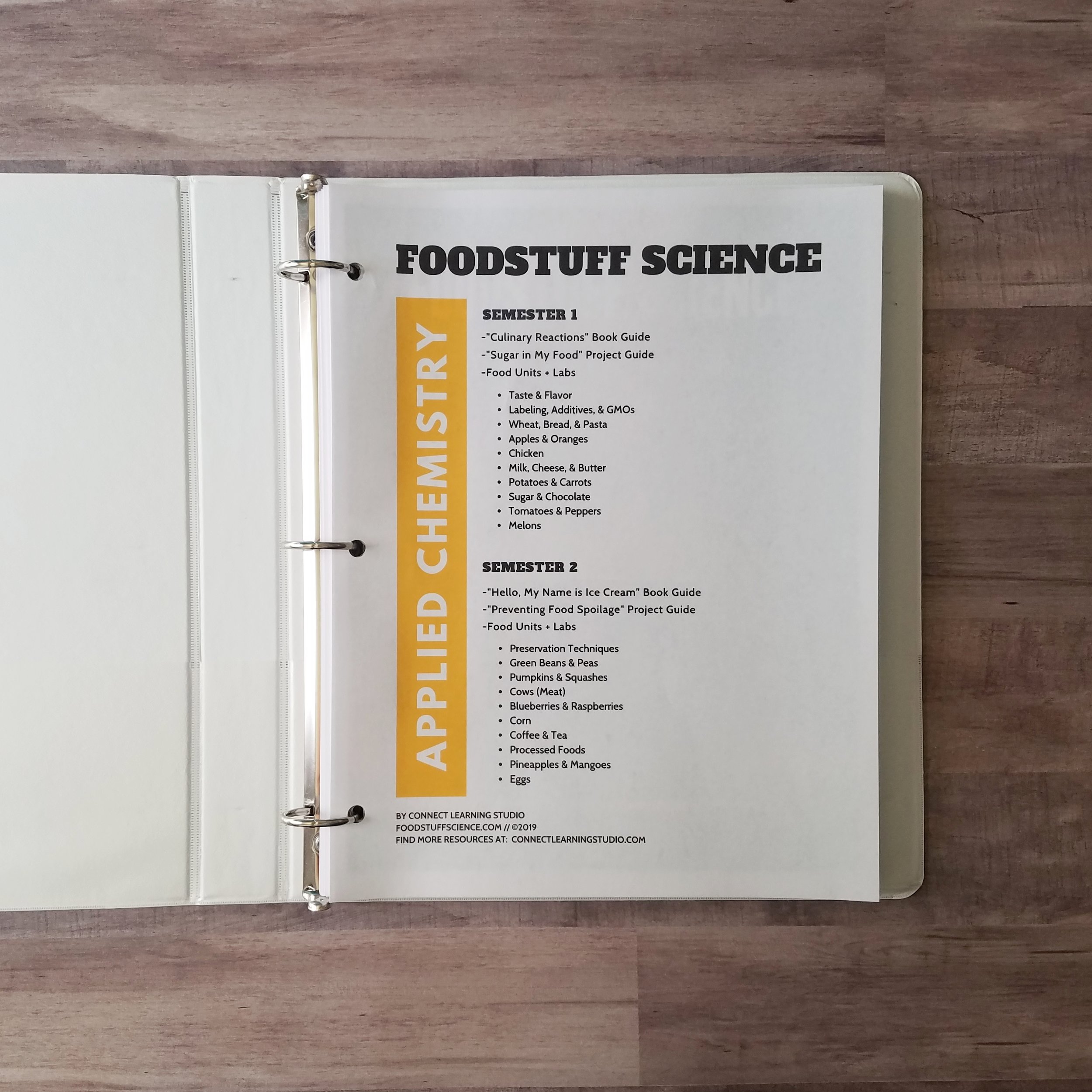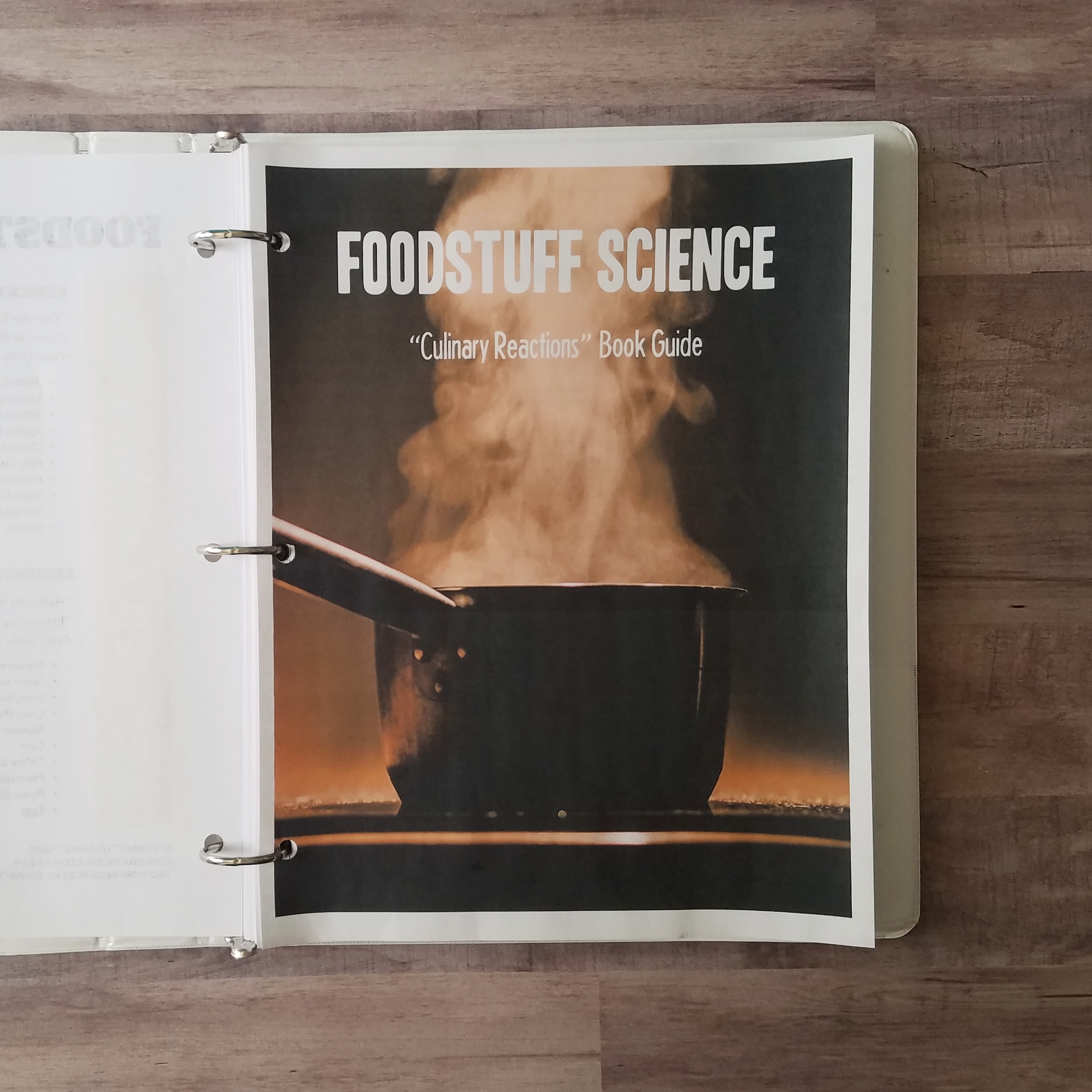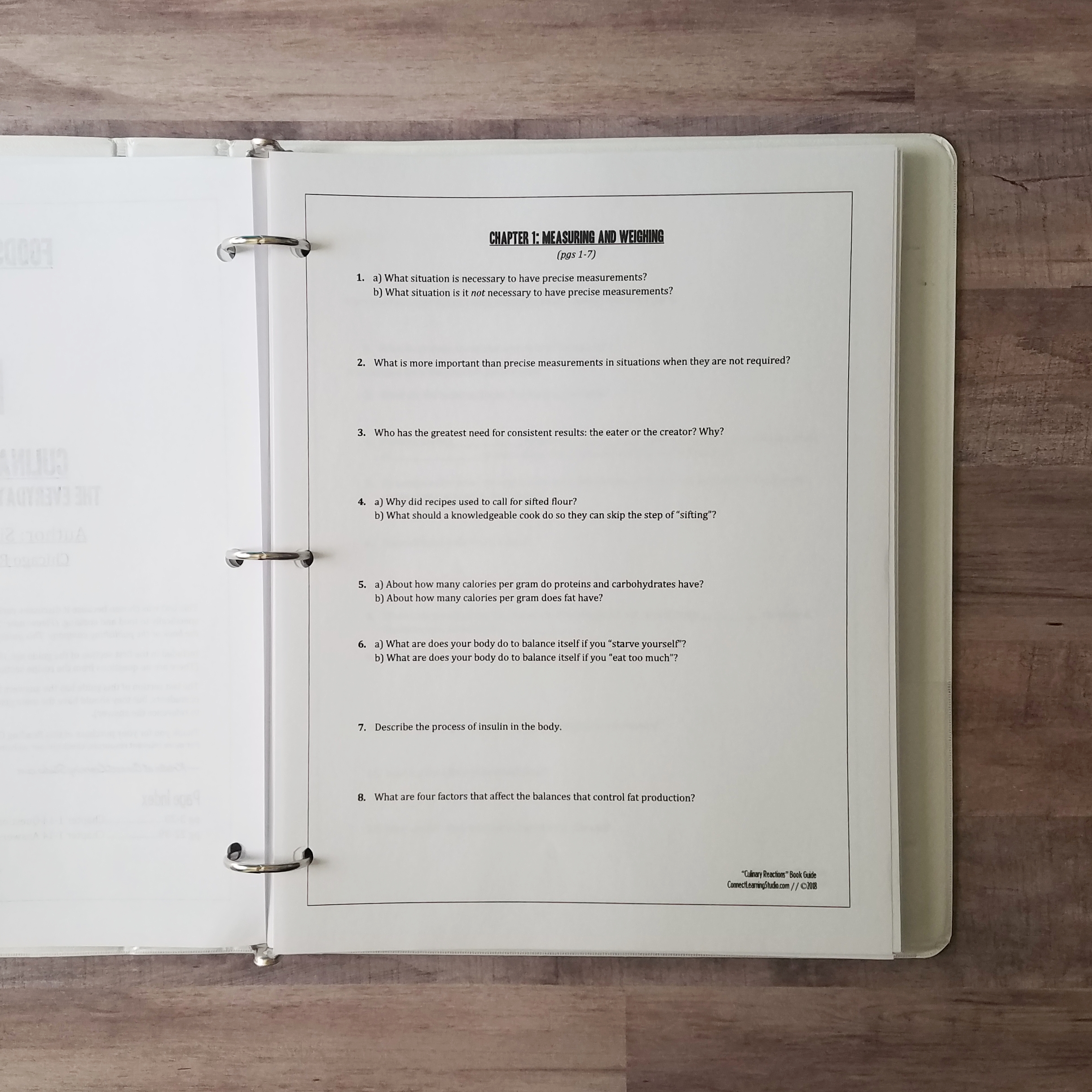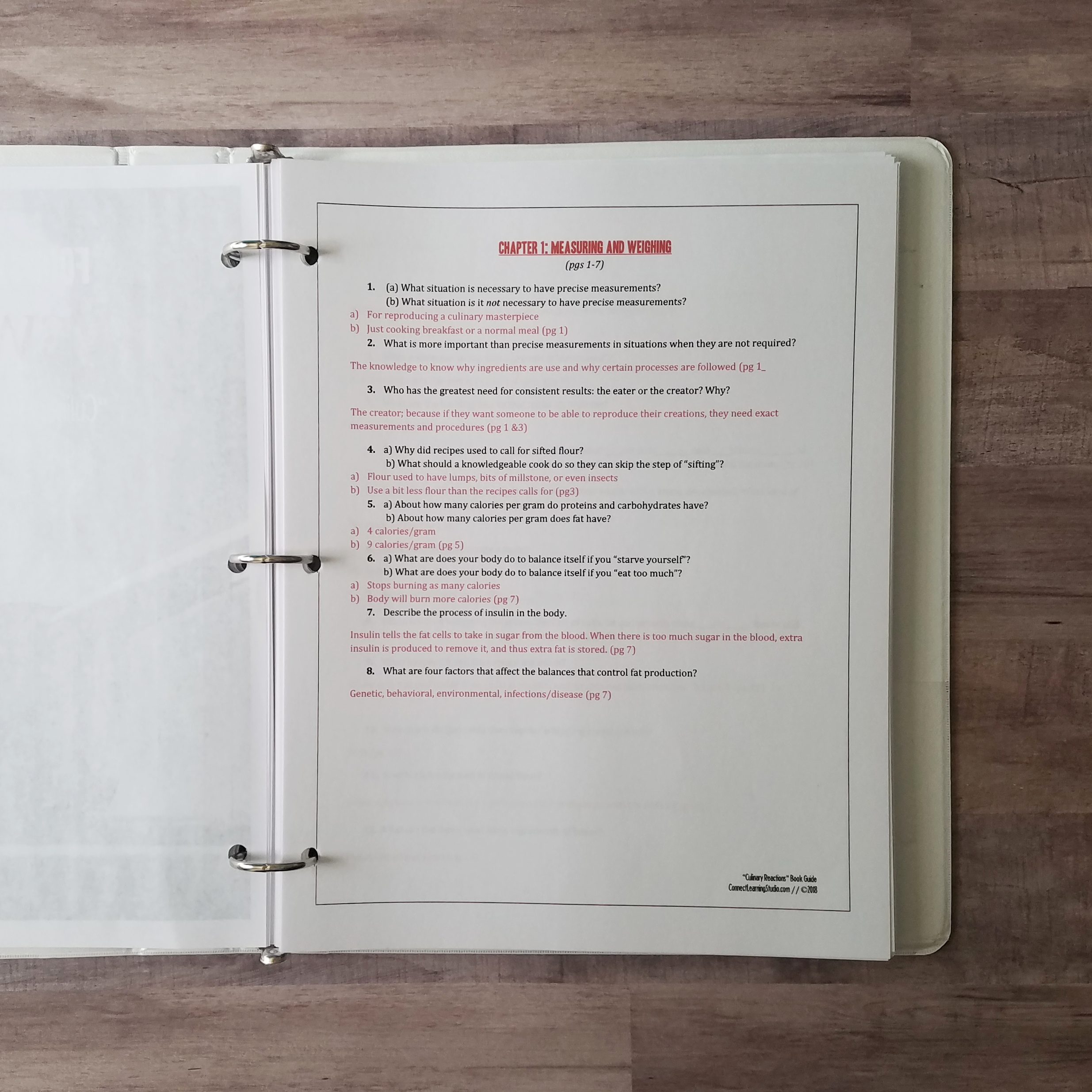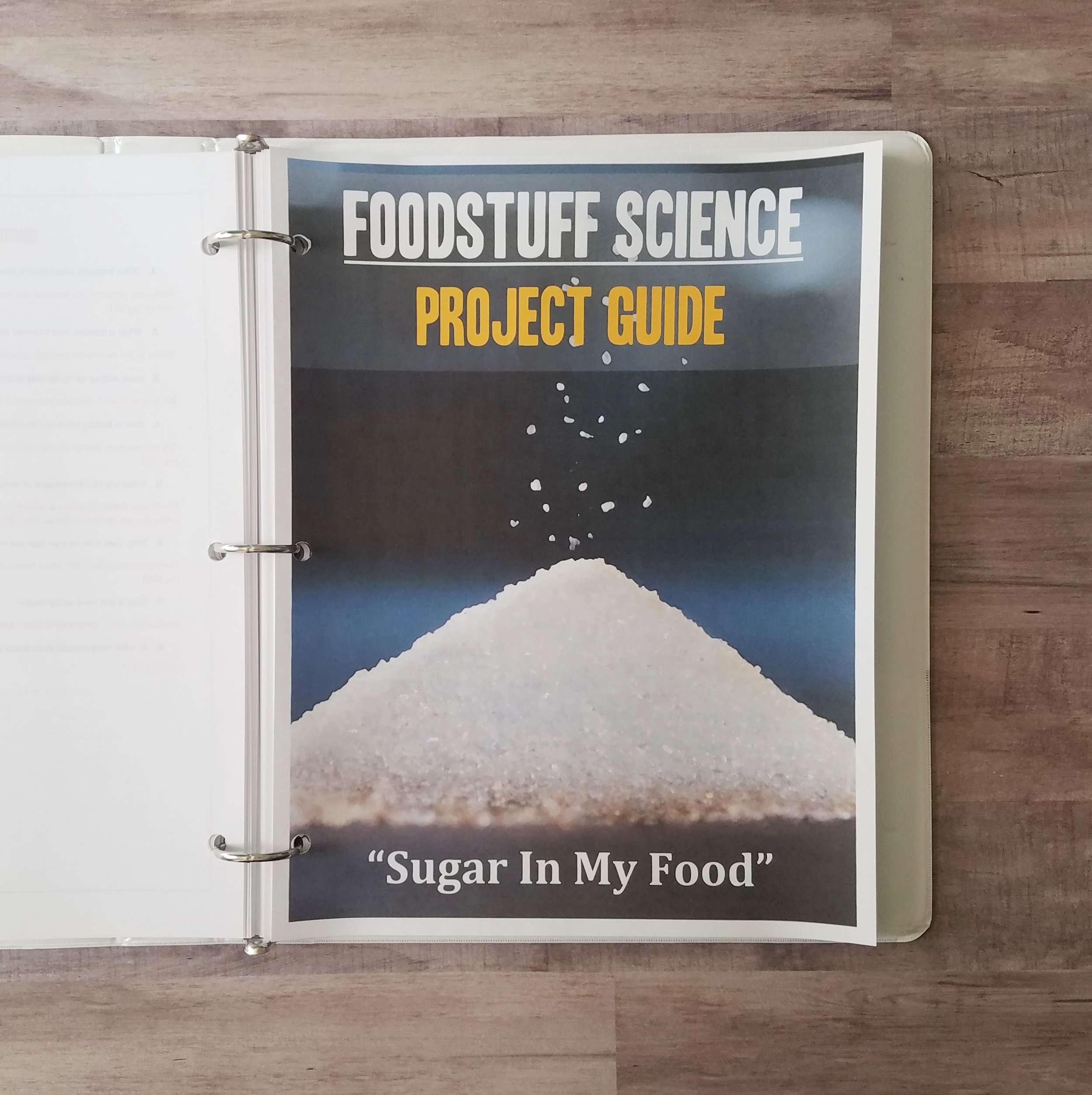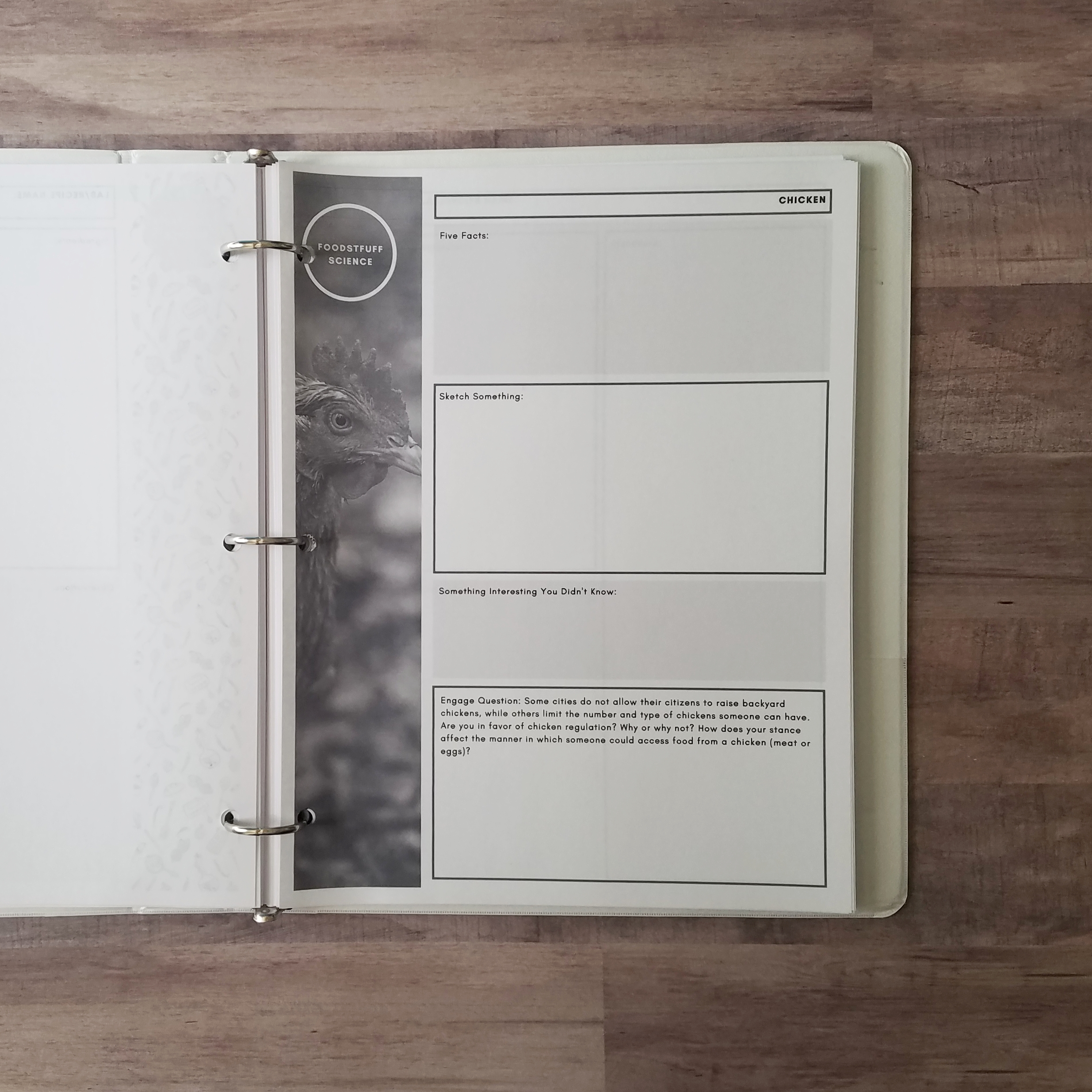This course is specifically an “Applied Chemistry” course – meaning the resources presented have been chosen to discuss more of the chemistry side of food, but also explores the processes, technology, history, and elements of everyday foods.
Each semester features a book guide, 10 unit studies, and a project guide. Within each unit, students will find a mixture of videos, articles, lab ideas (recipes!), and sketching inspiration for students recording their knowledge through journaling (highly recommended).
Get “Applied Chemistry” today as part of the FoodStuff Science Curriculum for only $39
Want to Check Out the Course?
Let us send you a free sample!!
Scope of "Applied Chemistry" Course Content
View a Printable Sample Weekly Assignment Sequence
Semester 1
Book Guide: “Culinary Reactions” by Simon Q. Field
Project Guide: Sugar in Popular Foods
Unit: Taste & Flavor
Unit: Labeling, Additives, & GMOs
Unit: Wheat, Bread, & Pasta
Unit: Apples & Oranges
Unit: Chicken
Unit: Milk, Cheese, & Butter
Unit: Potatoes & Carrots
Unit: Sugar & Chocolate
Unit: Tomatoes & Peppers
Unit: Melons
Semester 2
Book Guide: “Hello, My Name is Ice Cream” by Dana Cree
Project Guide: Highly Processed Foods versus Whole Foods in Your Diet
Unit: Preservation Techniques
Unit: Green Beans & Peas
Unit: Pumpkins & Squashes
Unit: Cows (Meat)
Unit: Blueberries & Raspberries
Unit: Corn
Unit: Coffee & Tea
Unit: Processed Foods
Unit: Pineapples & Mangoes
Unit: Eggs
Get “Applied Chemistry” today as part of the FoodStuff Science Curriculum for only $39
Who was this course designed for?
The course was designed to fulfill a "chemistry" course requirement, but we wanted it be relevant (everyone needs to eat!) and valuable for students beyond the just their academics.
If your student.........
loves watching videos for "schoolwork"
doesn't like to read a lot
is not mathematically ready for traditional chemistry
isn't going into a science-centered career
wants to learn something useful and relevant
likes to learn from a variety of materials (videos, articles, images, books)
likes to cook in the kitchen (or wants to learn)
loves sketching and drawing as way of learning
then this FoodStuff Science course is absolutely for them.
If you don't want to label this course as "Chemistry," we would recommend "Applied Chemistry" as a course label because it is the application of chemical knowledge to another field of study (culinary).
(As noted above, this is not your normal chemistry course. Students who might be college-bound into a science-related field might benefit from a more technical course or supplementing with another resource (such as "Homework Helpers: Chemistry" by Greg Curran which introduces students to the technical and mathematical concepts of chemistry).
What Chemistry Topics are covered in this course?
Denaturing
Types of chemical bonds
Emulsions
Colloids
Properties of Oils & Fats
Solutions
Crystallization
Protein Chemistry
Maillard Reactions
Acids & Bases
Oxidation
Polarity
Stabilizers
.... and more
(Most of the chemistry topics are explained and discussed in the core book for each semester. If you choose not to read the books, many chemistry topics may not be adequately reviewed in the unit videos and reading)
Get “Applied Chemistry” today as part of the FoodStuff Science Curriculum for only $39
What does the course look like?
The Applied Chemistry materials are available here at Foodstuff Science.com
When you click “Buy Now,” you will create an account for the member area, process your one-time payment, and then have access to all the links, PDF downloads, and other information that is available for the course. Then you can view on most internet connected devices or print out that materials as you want.
All course materials are ready to use and easily organized.
You don’t have to do any searching or googling for materials!
Get “Applied Chemistry” today as part of the FoodStuff Science Curriculum for only $39
What Books or Supplies Will We Need?
Core Reading Books
"Culinary Reactions" by Simon Q. Field
Available here on Amazon."Hello, My Name is Ice Cream" by Dana Cree
Available here on Amazon.
If you prefer, borrow from your library or buy "used" copies of the books - 2nd hand books are just fine (except for maybe the sketchbook)!
Notebook for Guides, Worksheets, and Labs Observations
Book Guides: Printable Questions (and Answers) for both Core Reading books
Projects Guides: Each semester has a project guide to help your student connect what they are learning with more knowledge or evaluation of how food affects their life. Projects can be as simple or complicated as you want your student to complete. These are great projects to help your student practice a "project skill" (such as Powerpoint, graphic design, etc), so you can adapt them as necessary for the skills of your student.
Unit Worksheets: Printable pages for all food units that include prompts for students to record what they learn from the unit videos and one “engage question” to encourage critical thinking
Lab Notes: Each unit has two recommended labs (or recipes). You can select to do as many labs as you want (or have your student just cook some of your regular meals). Supplies will vary based on your chosen recipes and frequency your student cooks. (As always, it is recommended to have adult supervision and for students to record their results and experience in their notebooks).
See my notebook below. You just print the PDFs & put in a 3 ring binder.
(Cover page and course contents printable included as well!)
Want to Check Out the Course?
Let us send you a free sample!!
How Do I Evaluate My Student's Success in this Course?
If your student finishes this course, please congratulate them! They have learned more about food (and the underlying chemical reactions) than most "successful" adults.
Because there are no tests or quizzes, there are a few ways you could "give a grade" to your student:
Did they complete all the assigned readings, videos, and questions?
Did they have a good attitude about completing their assignments?
Did they accurately answer questions from the two "semester reading" books?
Did they complete and present their "Project" in a clear, professional manner?
The weight of these benchmarks is completely up to you as your child's primary educator. Attitude may be more important than accuracy.
Standards for Choosing Materials
While designing the course, each video, article, and book has been selected from the thousands resources available online and in print with these guidelines in mind:
Resources absolutely do not have inappropriate language or adult references.
Resources may occasionally include references to evolution or young earth theories, but in general, resources are just about the facts (anything with a particular reference to evolution or young earth scientific theories will hopefully be noted with the video or reading). Also, one of the first chapters in the course discusses "scientific theories" to help create further discussion for you and your family)
Resources may selectively include topics relating to alcohol (it is a food/drink), but it is not focused on by any FoodStuff Science unit or guide (another topic to be evaluated by your family)
Resources are chosen for quality over quantity (meaning the longest videos or books aren't always chosen)
If you have a question about our guidelines or come across something you think shouldn't belong in our course, PLEASE CONTACT US! It is our hope to always offer safe, top-notch quality materials for your student in a world that doesn't necessarily respect parental boundaries.











